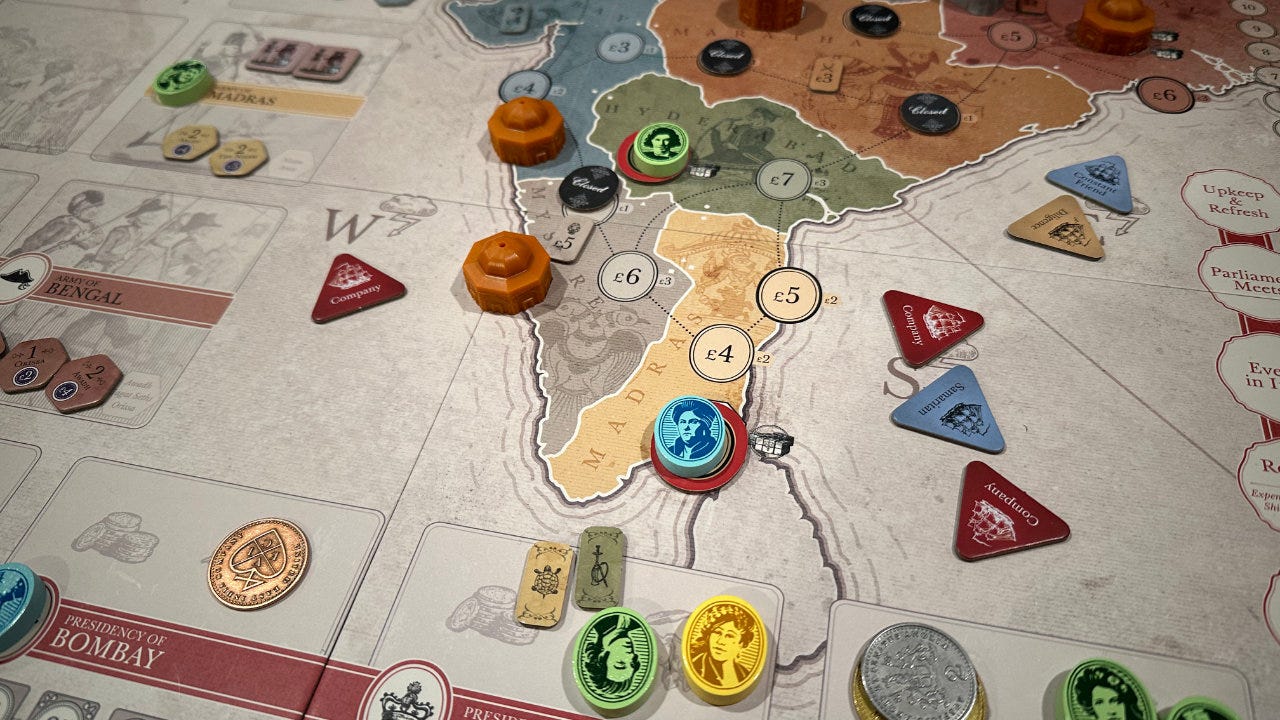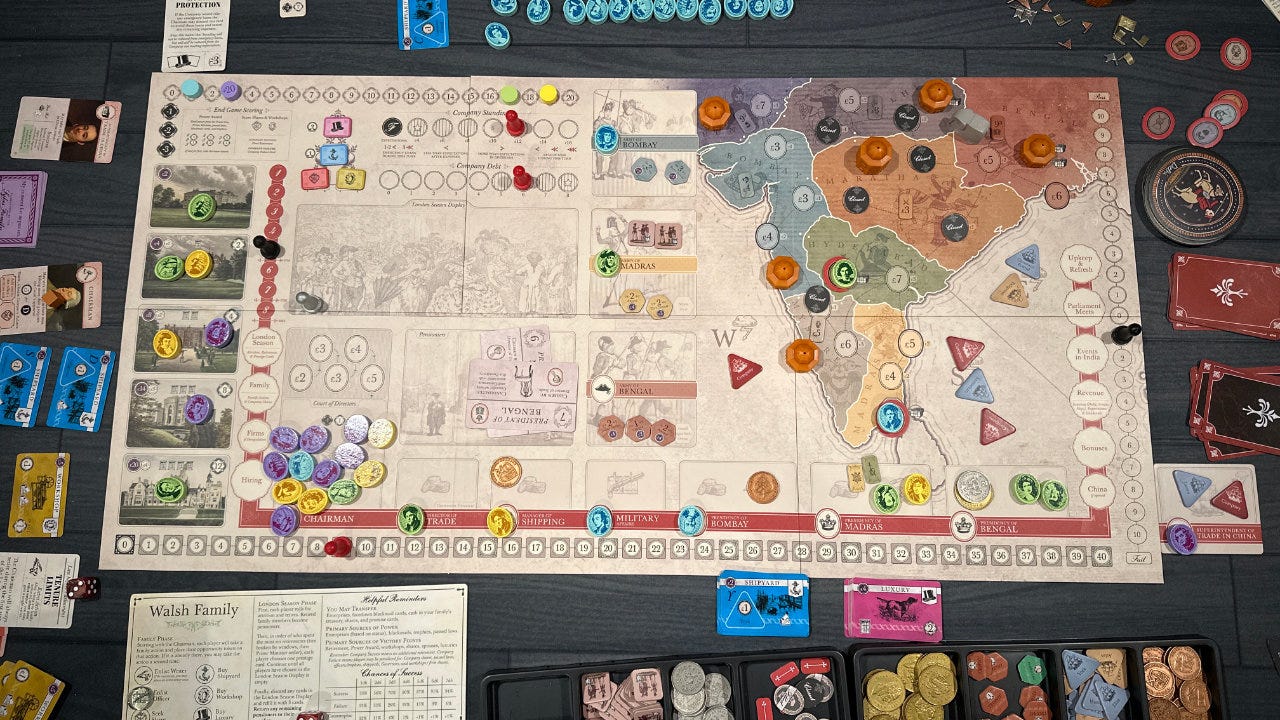Welcome to Skeleton Code Machine, a weekly publication that explores tabletop game mechanisms. Spark your creativity as a game designer or enthusiast, and think differently about how games work. Check out Dungeon Dice and 8 Kinds of Fun to get started!
I had to the opportunity to do quite a bit of gaming this weekend. Thirteen plays across twelve games to be exact. It included a wide variety of games ranging from a six hour game of John Company: Second Edition to a quick game of Unmatched.
It got me thinking about the design of each game: What was the most interesting bit? Did the mechanisms support the theme? How did it employ player agency?
So this week, we look at five of the games and try to find a useful lesson or tip from each one!
1. Star Wars: Shatterpoint
Star Wars: Shatterpoint (Shick, 2023) is an asymmetric miniatures skirmish game. I felt it was similar to Cyberpunk Red: Combat Zone, but with two interesting differences:
Moving objectives: Each of the three “Struggles” in the game has objective markers that have be to controlled. They are known in the first struggle, but you don’t know where they will be in the second or third struggles. This not only helps to balance the game, but forces players to use the entire battlefield.
Shrinking tug of war: We looked at tug of war mechanisms before. Shatterpoint uses a clear cube in the center of the track that you try to pull toward your side, which is pretty standard. The interesting part is that black cubes are added to either end that gradually shrink the distance needed to win. Cubes are added both from achieving goals (e.g. taking out an enemy unit) but also each round as a clock to force the game to end.
The shrinking tug of war track was fascinating and could be used both at a high level (e.g. game victory) and tactical levels (e.g. individual combat encounters) in other games.
2. Ra
Ra (Knizia, 1999) is a masterpiece of the auction/bidding genre. Reiner Knizia distills the genre to it’s pure essence, coated in Egyptian theme. Players bid and purchase tiles to get victory points from various forms of set collection.
Knowing when to trigger an auction: The auctions are interesting enough, but the real trick is knowing when to start an auction. Players pull chunky tiles which makes the pool increasingly attractive. Calling an auction stops the increase and players start bidding.
Bid on the tiles used in bidding: Rather than just bidding on tiles for set collection, you are also bidding on the tiles used as currency (i.e. the numbered tiles shown above). This adds an interesting layer of complexity to a relatively simple game.
I’m terrible at bidding games, but the mechanism has tons of potential. You can even use it for zero luck combat.
3. Zoo Vadis
Zoo Vadis (Knizia, 2023) is a reimplementation of Quo Vadis? (1992) with an animal theme. Players bribe and negotiate with each other to advance their animals along tracks to the victory zone at one end.
Trading superpowers: Asymmetric or variable player powers aren’t new, but in Zoo Vadis there’s a twist. You may not use your own special player power. You can only trade it away for someone else to use. This is a fascinating change that both increases and facilitates negotiation in the game.
Limited victory qualifications: You need an animal in the victory zone at the end of the game to even qualify to win, and there isn’t enough room for everyone. This creates a tense competition between wanting to go slow and collect more points vs. going fast to ensure you qualify.
4. Scout
Scout (Kajino, 2019) is a small, mostly abstract game from Oink. I’ve written at length about Scout as a ladder climbing game. Beyond that it does some interesting things:
Unchangeable hands: From the time you receive your cards you may not reorder or rearrange them. They have two values, but you have to pick which way to hold each one at the start of the game. Most games allow you to sort and move cards in your hand, and this might be the first I’ve seen that forbids it.
Single use power: Each player gets a token that allows them to both scout (i.e. take a card) and show (i.e. play a card) in the same turn. It’s single use and then gone for the round. Knowing when to save it and when to use it is a key part of the game.
The single use power is nothing new in the TTRPG world, especially when considering “once per day” actions or spells. Still, I think it has a lot of potential for new and different uses in the roleplaying world.
5. John Company: Second Edition
John Company: Second Edition (Wehrle, 2022) is a massive, complex, economic and negotiation game:
John Company is an interactive historical game about the rise and fall of the British East India Company from the designer of Root, Pax Pamir, and Oath. John Company is a business game with an important twist: players must collectively steer the fate of a single, sprawling organization. They must navigate its vast bureaucracy while reckoning with the consequences of their actions on the Indian subcontinent.
There are so many interesting things in this game, I’m not sure where to start. I’ll just pick two for now:
Vicious competitive cooperative play: Some games are cooperative like Pandemic. Others are competitive where only one person wins. John Company merges the two into a game where everyone (usually) needs the shared company to succeed, and yet they need to personally do better than any other player. It creates an atmosphere of deals, backstabbing, and extortion in a way I’ve never seen in other games.
Everything is negotiable: You can trade just about anything in the game: money, shares, future gains, ships, everything and anything. You also get personal Promise Cards that can be traded and actually handed to other players, who can then trade them again to other players. Much like trading powers in Zoo Vadis (see above), this helps facilitate negotiation in a really interesting way.
John Company deals with difficult issues, exploitation, and historical atrocities. I highly recommend watching the Shut Up & Sit Down review for context and considerations. The No Pun Included review of Cole Wehrle’s Pax Pamir: Second Edition is also worth watching for comparison.
Conclusion
Some things to think about:
There is always something to learn: While I thoroughly enjoyed the games listed above, no game is an exception. Even if the game is poorly designed or not fun, I still think there are things to learn… even if it’s learning what not to do.
Facilitating negotiation: My gaming group doesn’t always enjoy negotiation in games where it is unstructured. Both Quo Vadis (via power tokens) and John Company (via Promise Cards) add some structure and physical components to help makes that easier. I think it’s makes the games more accessible to players who might feel less comfortable negotiating at a table.
Reiner Knizia is amazing: As of March 2024, BGG lists 720 games as Reiner Knizia as the designer. His games are always fascinating examples of simple design, clean mechanisms, and shockingly tough choices. While his games might not be in my Top 10, I always look forward to playing them and learning from a master of game design. My recommendations include Tigris & Euphrates (1997), Ra (1999), Modern Art (1992), and Zoo Vadis (2023).
That’s ten tips from five games. Which one do you think is most inspiring for other games designs? Let everyone know in this week’s poll!
— E.P. 💀
P.S. Pre-orders for BLACKFLOWER, a CY_BORG heist, open soon. Sign up for the Exeunt Omnes newsletter so you don’t miss it!
Skeleton Code Machine is a production of Exeunt Press. All previous posts are in the Archive on the web. If you want to see what else is happening at Exeunt Press, check out the Exeunt Omnes newsletter.









Love the idea of the shrinking tug of war track. That mechanism too often doesn't end in a 'sudden death' way of hitting the end, which undercuts the tension a bit IMO. That's a nice way to enhance that part of it, particularly by having the shortening based on player actions.
Also, my "Trade on the Tigris" has a similar mechanism to Zoo Vadis, where players get ability cards that they can use as part of a trade. If they keep them, they can't use the ability. It only 'activates' when traded to another player. It really amps up the trade dynamics, and would love to see it used more.
So the John Company game made me think of my favorite board game of all time. Dune! (the game from Gale Force Nine). I adore the Dune setting but more than anything the ability to barter for anything is incredible. You can even barter for knowledge as one of the rules is that no one (except for 1 faction) can even write things down.
Have you ever played Dune before?